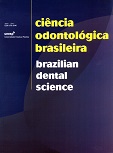Periodontal healing after Root conditioning using TTC-HCI or citric acid:
DOI:
https://doi.org/10.14295/bds.2006.v9i2.513Abstract
Tissue healing after periodontal therapy includes epithelial and connective tissue repair by producing biocompatible root surface. The objective of this study was to investigate whether etching solutions such as Tetracycline-hydrochloride (TTC-HCl) or citric acid might enhance the healing after periodontal therapy in rats. Periodontal defects were induced on the left maxillary 2nd molar in 36 Wistar rats. The periodontal attachment was reduced using a ligature model. The experimental sites were mechanically treated and delineated by blindly preparing a notch at the most apical aspect of the pocket using a Hedstroen endodontic file. The experimental sites were irrigated with a 10% tetracycline hidrocloride solution, an 8% citric acid solution, or a 0,9% NaCl solution (control) thus forming 3 groups of 12 animals each. The animals were euthanized at 3, 7 and 21 days post-treatment when block sections of the experimental sites were collected for histometric analysis. The histological observations describe normal wound maturation without regeneration in the defective site. Using a grid point counting method and two-way analysis of variance, it was shown that tissue fill in the notch did not differ significantly between sites irrigated with the acid solutions. However, tissue fill in these sites was significantly smaller than in the control sites. The results also showed that the area occupied by inflamed connective tissue was wider in the control compared to sites treated with the acid solutions. Based on these results it was concluded that irrigation with an acid solution could enhance healing following periodontal therapy
Downloads
Downloads
Published
How to Cite
Issue
Section
License
Brazilian Dental Science uses the Creative Commons (CC-BY 4.0) license, thus preserving the integrity of articles in an open access environment. The journal allows the author to retain publishing rights without restrictions.
=================




























